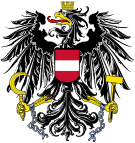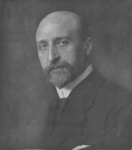(Redirected from Austrian legislative election, 1930 )
1930 Austrian legislative election National Council
First party
Second party
Leader
Karl Seitz
Karl Vaugoin
Party
SPÖ
CS
Last election
42.28%, 71 seats
48.24%, 85 (EL)
Seats won
72
66
Seat change
Popular vote
1,517,146
1,314,956
Percentage
41.14%
35.65%
Swing
pp
pp
Third party
Fourth party
Leader
Franz Dinghofer
Ernst Rüdiger Starhemberg
Party
GDVP –LB
HB
Last election
6.32%, 9 (LB)
–
Seats won
19
8
Seat change
New
Popular vote
428,255
227,401
Percentage
11.61%
6.17%
Swing
pp
New
Parliamentary elections were held in Austria on 9 November 1930. The Social Democratic Workers' Party emerged as the largest faction in the National Council , with 72 of the 165 seats, but the Christian Social Party (with 66 seats) formed a new coalition government with Otto Ender as Chancellor. Voter turnout was 90%.
This was the last parliamentary election to take place in the period of the First Austrian Republic . A series of socialist-fascist clashes in 1934 was followed by the authoritarian Federal State of Austria and eventual Anschluss in 1938 with Nazi Germany .
Results
Party Votes % Seats +/– Social Democratic Workers' Party 1,517,146 41.14 72 +1 Christian Social Party 1,314,956 35.65 66 – National Economy Bloc (GDVP –LB ) 428,255 11.61 19 – Homeland Bloc 227,401 6.17 8 New German National Socialist Workers' Party 111,627 3.03 0 0 Landbund for Austria 43,689 1.18 0 – Communist Party of Austria 20,951 0.57 0 0 Austrian People's Party 14,980 0.41 0 New Democratic Centre Party 6,719 0.18 0 New Jewish List 2,133 0.06 0 New Kaiser Loyalty People's Party 157 0.00 0 New National Democratic Association 54 0.00 0 New Total 3,688,068 100.00 165 0 Valid votes 3,688,068 99.24 Invalid/blank votes 28,098 0.76 Total votes 3,716,166 100.00 Registered voters/turnout 4,121,282 90.17 Source: Nohlen & Stöver
Results by province
Province
Votes
SDAPÖ
CS
GDVP –LB
HB
DNSAP
LB
KPÖ
ÖVP
DCP
JL
KLPP
NDA
%
%
%
%
%
%
%
%
%
%
%
%
Vienna
1,192,672
58.98
23.72
10.43
2.21
2.31
0
0.89
0.71
0.56
0.18
0.01
0
Lower Austria
818,302
35.63
44.13
8.58
6.62
4.2
0
0.5
0.34
0
0
0
0
Upper Austria
479,285
28.37
45.42
7.29
8.29
2.41
7.71
0.25
0.27
0
0
0
0
Salzburg
123,152
29.96
41.52
12.69
5.73
3.69
5.49
0.61
0.30
0
0
0
0
Tyrol
176,843
21.99
54.97
12.34
9.28
1.24
0
0.17
0
0
0
0
0
Vorarlberg
77,516
20.92
56.79
20.94
0
1.14
0
0.22
0
0
0
0
0
Styria
510,164
34.38
32.52
16.51
12.48
3.42
0
0.39
0.31
0
0
0
0
Carinthia
175,640
38.73
22.54
22.38
8.47
6.90
0
0.66
0.32
0
0
0
0
Burgenland
134,494
37.75
41.23
16.01
3.80
0.75
0
0.47
0
0
0
0
0
Total
3,688,068
41.14
35.65
11.61
6.17
3.03
1.18
0.57
0.41
0.18
0.06
0.00
0.00
Source: Statistische Nachrichten : Sonderheft. Die Nationalratswahlen vom 9. November 1930, 12.
References
Nohlen, Dieter ; Stöver, Philip (31 May 2010). Elections in Europe: A data handbook . Nomos Verlagsgesellschaft. p. 196. ISBN 978-3-8329-5609-7 "Sonderheft der Statistischen Nachrichten 9 November 1930" (PDF). Bundesministerium für Inneres. Archived (PDF) from the original on 9 July 2022.
Categories :
Text is available under the Creative Commons Attribution-ShareAlike License. Additional terms may apply.
**DISCLAIMER** We are not affiliated with Wikipedia, and Cloudflare.
The information presented on this site is for general informational purposes only and does not constitute medical advice.
You should always have a personal consultation with a healthcare professional before making changes to your diet, medication, or exercise routine.
AI helps with the correspondence in our chat.
We participate in an affiliate program. If you buy something through a link, we may earn a commission 💕
↑
 Results by state
Results by state






